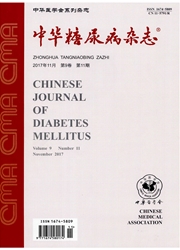

 中文摘要:
中文摘要:
目的探讨糖化血红蛋白(HbA1c)与冠心病血运重建患者心脏收缩功能的相关性。方法利用医院电子病例系统筛选2010年1至12月在北京安贞医院行冠状动脉搭桥术(CABG)或冠状动脉介入术(PCI)的住院患者,按照是否伴有糖尿病、糖化血红蛋白是否高于6.5%和8.0%两个切点、术后射血分数(EF)是否高于50%各分为两组,考察各项指标,以多因素Logistic回归分析HbA。和冠心病血运重建患者心功能的相关性。结果(1)294例患者中男211例(71.8%),女83例(28.2%),年龄(61±10)岁。124例(42.2%)伴有糖尿病。(2)空腹血糖、HbA。和甘油三酯水平在伴有糖尿病的患者中高于不伴糖尿病者,同时,上述三项指标在射血分数(EF)〈50%的患者中高于EF≥50%的患者,差异具有统计学意义(均P〈0.05)。(3)HbA1c≥6.5%者中EF〈50%的比例高于HbA1C〈6.5%的患者(20.7%比12.0%,X^2=4.403.P〈0.05)。调整相关影响因素后HbA1c≥6.5%与心衰发生的风险相关(OR=2.204,95%CI:1.135-4.283)。结论HbA1c≥6.5%可能与CABG或PCI术后患者心功能减低相关。
 英文摘要:
英文摘要:
Objective To investigate the relationship between glycosylated hemoglobin (HbA1c) and cardiac systolic function in patients with coronary artery revascularization. Methods Hospitalized patients who underwent coronary artery bypass grafting (CABG) or percutaneous coronary intervention (PCI) at Beijing Anzhen Hospital from January 2010 to December 2010 were selected from the electronic medical records system. Participants were stratified by the presence of diabetes mellitus, HbA, higher than 6.5% and 8.0%, and ejection fraction (EF) higher than 50%, respectively. Multivariate Logistic regression was used to analyze the correlation between HbA1c, and EF in patients with coronary revaseularization. Results (1) Of 294 parients, 211 (71.8%) were male and 83 (28.2%) were female, with a mean age of (61± 10) years. 124 patients (42.2%) were with diabetes mellitus. (2) The levels of fasting plasma glucose (FPG), HbA,,. and triglyeeride (TG) were higher in patients with diabetes than those without diabetes, and the above three indexes were higher in patients with EF〈50% than those EFt〉50% , the differences were statistically significant (P〈0.05). (3) The number Of patients with EF〈50% was higher in those with HbA1c≥6.5% (20.7% vs 12.0%, X^2= 4.403, P〈0.05). HbA1c≥6.5% was associated with increased risk of heart failure after adjustment for related influencing factors (OR= 2.204, 95% CI: 1.135-4.283). Conclusion HbA1c≥ 6.5% may be associated with decreased cardiac function after CABG or PCI.
 同期刊论文项目
同期刊论文项目
 同项目期刊论文
同项目期刊论文
 期刊信息
期刊信息
